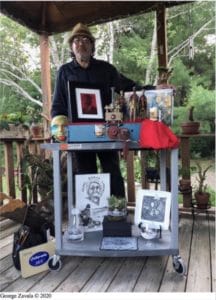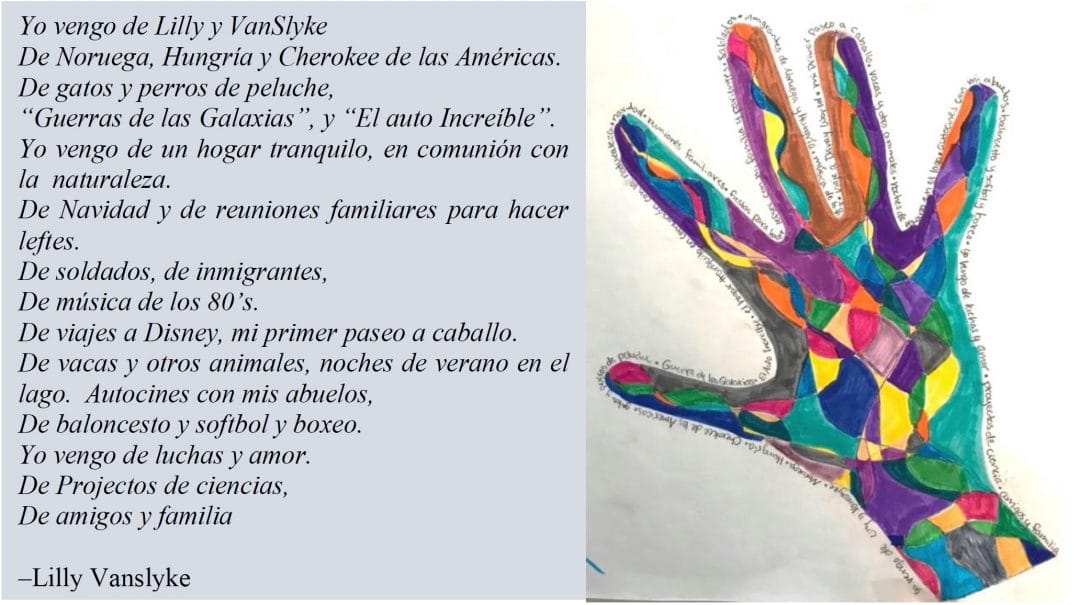
As part of Local Learning’s 2020 third annual New York State Culture, Community, and the Classroom initiative in Corning-Elmira, high school Spanish teacher Vivian Muñoz hosted George Zavala in a virtual classroom residency. Along with 40 other educators, eight folk artists, and several folklorists and museum educators in a July Zoom workshop, Vivian learned about integrating local art and culture into the classroom, interviewing tools, and collaborating with guest artists. An experienced teaching artist who worked with City Lore and Mind-Builders in NYC before moving to western New York, George brought his gifts of listening closely to teachers, envisioning curricular connections, and integrating art into any subject area and grade level. The eight educators and artists who had classroom residencies presented highlights from their experiences in a virtual Culture, Community, and the Classroom Showcase hosted by the Rockwell Museum in Corning. Here Vivian and George share their experience.
George Ella Lyon
Gracias to the writer George Ella Lyon, whose 1993 poem “Where I’m From” has inspired thousands of people to write about where they come from; what matters most to them; how traditions, people, and places shape them. George Zavala developed a Spanish version, “Yo vengo de,” for his Local Learning folk arts residency in Vivian Muñoz’s 9th-grade Spanish class at Corning-Painted Post High School in Corning, NY. Learn about Lyon, the former Kentucky poet laureate, read her original poem, and find suggested activities for teaching with this poem on her website http://www.georgeellalyon.com.
Vivian
I had never worked with a visual artist before. George made it so easy. He is caring and perceptive and gave me room to create a teaching plan. After a half-dozen planning phone calls, we met by Google Meets with students four times because our school was all virtual at that time. He shared some of his artwork for me to critique, and through one of his drawings and conversations I discovered that we had lived in the same town in Puerto Rico. Now we live in the same New York town. When I told him that I would be teaching a unit on identity, he suggested asking students to write “Yo vengo de” poetry to inspire and incorporate into visual art collages.
George
I know that working with an artist can be a little intimidating for teachers. I want them to be comfortable and to see how what they have to teach can naturally fold in with artmaking. It’s about process as well as product. With Vivian’s students studying identity, I knew that as adolescents they would be searching for identity as part of growing up and that the “I Am From” poem would work well.

Vivian
To introduce George, I shared the Artist Statement and Artist Portrait that George created during our summer Culture, Community, and the Classroom workshop. George wrote his statement in English and in Spanish. I used the Spanish version. I then showed slides of some of his artwork and asked students to look closely: “What do you see? What does this image tell you? What colors and objects do you see? What do you think is going on here?” They were not shy about answering: “I see NYC and Puerto Rico.” “Family.” “Home.” “Protests.”
Before George came to class, we talked about the importance of manners, practicing good online or virtual learning etiquette, leaving cameras on when possible, asking good questions, and listening closely. Students were very polite and quickly felt at ease. When students met George, they were surprised at how much they had learned about him from his art.
George Zavala, Obrero del arte
Desde mi niñez me ha fascinado el arte y las formas diversas y únicas con la cual se comunica. A través del arte yo aprendí a hablar inglés, lenguaje de la tierra donde nací y fue el arte que me sirvió de guía, ayudándome a navegar esta nueva cultura americana con un lenguaje y costumbres tan diferentes a los de mis raíces puertorriqueñas. En mi juventud el arte se convirtió en una herramienta para explorar mi persona y mi mundo y un vehículo para mi expresión política. El arte es el enlace con mi herencia ancestral y mi conexión universal con otros pueblos y sus culturas. A través de mi vida el arte siempre ha sido la forma por la cual exploro el mundo y manejo sus complejidades. A través de mi trabajo en las artes visuales y el teatro, he tenido la buena fortuna de poder ganarme la vida creando arte con gente diversas de muchas comunidades culturales y he sido testigo de cómo el arte puede ser un puente para crecimiento personal, aprendizaje mayor y crecimiento socio político/ espiritual. Explorando cultura y tradiciones utilizando el arte de collage ha sido una manera maravillosa de crear arte uniendo imágenes y palabras en una composición. Yo creo y tengo fe en el poder del arte para transformar y liberar y me considero bendecido tener el arte como el trabajo que me ha sostenido hasta el día de hoy. [See English translation at end of article, eds.]
George
To get students started, I read my “Yo vengo de” poem and told students that brainstorming in English first would produce richer ideas for their poetry. The final product would be in Spanish, but they would be building on familiar words and topics important to them. I developed a worksheet with prompts in English. I encouraged the students to use their homes and family stories as part of their research. Many of them commented on learning new things about their family history by looking at objects, photos, and artifacts in their surroundings and conversations with their parents and family members. Next they had to think about distilling: What do I remove? Which essential words should go in the poem? Then they translated these words into Spanish, but they also had to write poetically, so artistry had to go into the translating. As they began to share their poems, students found many surprising connections to one another, just as Vivian and I had. For example, three had lost siblings.

Vivian
During the pandemic, educators and students have been hearing a lot about Social Emotional Learning (SEL). The work that we did with George was very much in line with SEL. Students were opened to one another’s vulnerability, respectful, and connected. Another important aspect was how their vocabularies bloomed. Students learned new Spanish words relevant to their personal poems, and they used these words in other contexts. Unlike a standard vocabulary lesson in which everyone learns the same words, they have unique new words.
George
To turn their “Yo vengo de…” poems into a visual format, Vivian and I discussed using collage as a medium because the students could use images and words to create their pieces. It was a familiar art form and could be easily done at home or in class. I decided to have the students trace an outline of their hand as the “canvas” for their work. We discussed the uniqueness of each individual hand and the use of hands in art throughout history, going back to ancient hand drawings in caves. We viewed images of the prehistoric hand paintings discovered in the Cave of Hands, Cueva de las manos, in Argentina. I spoke about the use of hand imagery in my own artmaking and showed some examples.
I also liked that the hands would be a unique imprint of each individual student, which tied into the theme of “Identity.” At the same time, they would be a common visual element joining all the students’ work together. The hand is also an appropriate metaphor for individual contributions necessary in building community. As we got closer to the actual art-making process, we also offered students the option of using just words or just drawings within the student’s hand outline, to give the class more creative choices. I also made a “word” hand and a “drawing” hand as well as a “collage” with my own hand outline to use as examples for them.
Vivian and I decided on 9” x 14” cardstock for each student’s work, but 9” x 10” or 8” x 10” heavy stock or watercolor paper also work well. She prepared the cardstock and packets of materials that she gave to students when they came for in-person class time. Collage materials included scissors, images from magazines, copies of photos, images from the Internet, colored pencils, markers, pens, pencils, glue sticks or white glue. Hands are the most important tool! This was my first experience doing a Zoom art project after many years of art making in person with students. Thanks to Vivian’s passion and dedication to the process, it was an incredibly effective experience.
I’m a recent addition to this area, and it was wonderful meeting the students and learning about my new community through their creative process and the beautiful art they produced. After the project ended I received a package of notes and art from the students speaking of their experience and the cultural awareness they experienced through the process. Their messages were very moving and really confirmed the success of the workshop.
Vivian
There is so much that the students learned. In addition to expanding their Spanish vocabulary authentically and individually, they developed deeper ideas about identity and connectedness. When the students shared their final poems and artwork, their peers were so attentive, respectful, and empathetic. We had a Google “gallery walk,” and students could choose to be anonymous, to keep their privacy.
We planned to share the work on Parents’ Night, but the event was cancelled. I am framing the artwork and will surprise them at the end of the school year. I hope that the students will hang onto their work and remember how much they learned about themselves, how people and families connect with one another, what gives life meaning.
Vivian Muñoz teaches Spanish at Corning-Painted Post High School in Corning, NY. She is also Chair of the Corning-Kakegawa, Japan Sister Cities.
George Zavala is an artworker currently living in the Finger Lakes region and was a teaching artist in NYC from 1988 to 2019. ORCID 0000-0002-1175-353X
English translation of George Zavala’s Artist Statement shared with Vivian’s students:
Meet George Zavala, Art Worker
Since my early childhood I have been drawn to art and have always been fascinated by the diverse and unique forms through which it communicates. Through art I learned to speak and write in English, language of the land of my birth, and art guided me into this new American culture whose ways and language seemed so different from those of my own Puerto Rican roots. As a young man, I used art as a tool to explore myself and my world, and art became a vehicle for my political expression. Art is the path to my ancestral heritage and the road to my universal connection with all peoples and cultures. Throughout my life making art has been the means through which I experience the world and deal with its complexities. Through my work in the visual and theater arts I have had the good fortune to create art with many different people from many cultural communities and have witnessed how art can become a bridge to personal awareness, higher learning, and sociopolitical and spiritual awareness. Exploring culture and traditions through collage has been a wonderful way to create art by bringing together images and words into one composition. I believe in the power of art to transform and liberate and consider myself blessed to have art as the labor that has sustained me to this day.



